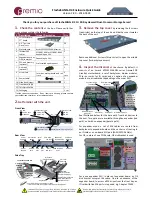
a) Issue the following command:
sg_ses <dev> -p7 | finstr /i esce
Note: For scsi<dev>, type the number of the SCSI device recorded in the previous
step.
b) The IP Address for each IOM will appear at the end of each resulting line. Each IP Address is labeled
for either IOM A or IOM B and occurs after the last comma as seen bolded in the following example.
3. Verify the IOM SAS Address that matches each SCSI device that is linked to each IOM using sg_vpd page
83h.
a) Issue the following command:
sg_vpd
<dev>
-p0x83
b) Identify and match the IOM SAS address and sg device for both IOMs from the output. Each address
appears bolded in the example below.
Addressed logical unit:
designator type: NAA,
code set: Binary
0x
5000ccab0300003c
Target port:
designator type: NAA,
code set: Binary
transport: Serial Attached SCSI Protocol (SPL-4)
0x
5000ccab0300003c
designator type: Relative target port,
code set: Binary
transport: Serial Attached SCSI Protocol (SPL-4)
Relative target port: 0x1
Target device that contains addressed lu:
designator type: NAA,
code set: Binary
transport: Serial Attached SCSI Protocol (SPL-4)
0x
5000ccab0300003c
4. Build the sg_senddiag command using the information recorded in earlier steps.
a) Use the example of the sg_senddiag command shown in the image above to complete the specific
sg_senddiag command for IOM A. Replace letters a through d with the information recorded in previous
steps.
Figure 190: sg_senddiag Command
a. SCSI device (<dev>): device associated with IOM A
b. Disable Zoning: 60
c. Zoning Configuration: configuration 00
180
5
System Management
User Guide
5.2
Zoning
















































